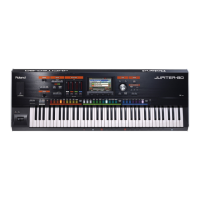String sounds...
Acoustic-guitar sounds...
Piano sounds...
Brass sounds...
Time
■ Image: Envelope actions of the JUPITER-80/-50.
Level
Level
Frequency
The response of the LPF
when the resonance is zero
■ Image: LPF actions of the JUPITER-80/-50.
SAW
SQUARE
PULSE/PWM
TRIANGLE
SINE
NOISE
SUPER SAW
JP-8 Saw
MG Saw 1
GR-300 Saw
P5 Saw
JP-8 Pls 05
Sync Sweep
Unison Sync+
X-Mod Wave 7
FeedbackWave
SubOSC Wave3
JD Fat Saw
VP-330 Choir
Heaven Wave
DigiSpectrum
Syn Vox 2
SBF Lead 1
Atmosphere
FM Bell
5th Wave
Wave Table
JLOrg1 Fst L
FM EP 4
Dist Gtr 2
Solid Bass
FM Super Bs
Metal Vox 3+
Strings 5 L
Tp Section
Orch. Hit
Scratch 6
■ Image: Filter actions of LPF-1, -2, -3,-4.
Frequency
LPF1
LPF2
LPF3
LPF4
Level
Authentic synth sounds — from classic vintage analog
to modern digital
Three new vintage-inspired
LPF onboard
Reproducing acoustic instruments with
SuperNATURAL
To faithfully recreate the unique sound of analog synths, we've meticulously
analyzed the behavior of oscillators, filters, and envelopes that are unique
to analog synths. In the new JUPITER series, a single synth tone comprises
three OSC, FILTER, AMP, and LFO chains, which give you absolutely powerful
synthesis control over a single tone. You also have access to ring modulation,
WAVE shapes for creating complex tones, and the popular UNISON mode,
which lets you overlay up to eight waves per OSC to create thick and fat
analog synth tones.
The filter section, which is a key to
creating expressive synth tones,
now comes with three new types of
vintage-inspired LPF (low-pass filter),
bringing the total to four types of
filters to chose from. These filters
allow you to create sounds that
are reminiscent of vintage analog
synthesizers.
When you play the JUPITER-80/-50, you'll
immediately be amazed at the quality and realism
of its rich SuperNATURAL acoustic sounds, and
how naturally and organically they respond and
evolve in response to your touch and phrasing.
You can enhance the performance characteristics
with expressive controllers such as pitch-bend/
modulation lever, assignable buttons (S1 and S2),
and D-Beam Control.
n
More than 350 types of PCM digital-synth waveform
patterns are onboard, plus a coveted collection of analog
waveforms that harkens back to classic vintage synths.
Seven types of analog
waveforms provide the DNA
of vintage synthesizers.
PCM waveform patterns let you recreate contemporary digital synth sounds.
n
Emulates the filter behavior of an analog synthesizer
The LPF plays an important role in shaping the tone. It can be used
to cut elements from the sound, and can also be used to emphasize
elements around the cutoff frequency with resonance. When you
control the resonance in an analog synth, the cutoff frequency
fluctuates, and signal levels below the cutoff frequency are affected
as well. The entire filter changes organically as if it's alive. These
changes occur due to the behavior of the analog circuits and the
components used, such as resistors and condensers, which make
up the unique sound of an analog synth.
n
Four types of LPFs with unique behavior
The JUPITER-80 and -50
feature four types of LPFs.
Each filter behaves differently,
even if their cutoff and
resonance parameters are the
same. The LPF is personalized
by its parameter settings
and real-time control cutoff
frequency and resonance.
n
Emulates the envelope behavior of an analog
synthesizer
In an analog synth, the electric charge/discharge rate of the envelope
rises and falls in a slightly curved line. The JUPITER-80 and -50 faithfully
reproduce this attribute for all of its envelopes, including the oscillator,
filter, and amplifier. By using this envelope to control the four LPF types,
the resulting sound has an incredibly smooth analog feel.
Grand-piano sounds exhibit natural decay and
seamless tonal changes in response your touch.
You can adjust a variety of parameters, such as
Stereo Width and Hammer Noise.
The JUPITER faithfully reproduces the dynamic
tonal changes unique to brass instruments --
including the transitions of harmonic overtones
with a dramatic raise in pitch and the half-valve
sound when playing trills.
Pitches transition naturally from note to note
when playing tied legato-style melody lines.
Effortlessly realize portamento, pizzicato, and
other articulations unique to string instruments --
no special playing technique required.
Reproduce chord fingerings, strumming, and
melody performances of steel- and nylon-string
guitars naturally and easily -- right from your
keyboard.
n
Examples of SuperNATURAL acoustic tones:
SuperNATURAL sound — ultimate expression and authenticity
Enhanced SuperNATURAL Synthesizer Tones SuperNATURAL Acoustic Tones

